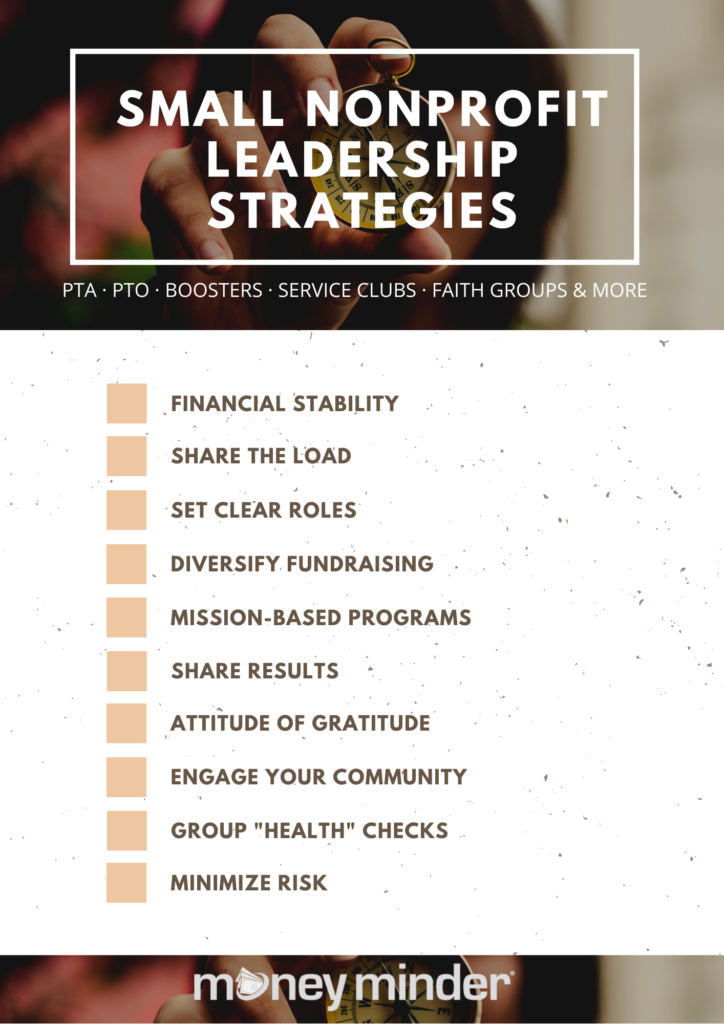Having a leadership role in a small nonprofit like a parent group, service club, sports team or more can add a lot to your plate. These are almost always volunteer positions for already busy people. And whether your group is a team of three or a small army consisting of a Board of Directors, officer positions, members and volunteers, there is still a group with a mission that relies on your leadership.
If you’ve ever gained leadership skills from a business management course, you’ll find that much of that education applies to nonprofits. Following a few nonprofit leadership techniques can help you succeed and reduce the stress of the added commitment. Seeing that your nonprofit is thriving as a direct result of your leadership is one sure fire way to make the role worthy of your valuable time.
Effective Nonprofit Leaders Start Here.
- Financial Stability. Just as in business, people have a hard time respecting a nonprofit that does not have its financial ducks in a row. If you are unable to balance the money that comes in via fundraising, dues and other programs, with the money that goes out, you are likely to be seen as a poor leader. Prioritize financial stability by using simple accounting tools built for volunteers. These don’t have to cost an arm and a leg, but they should check some basic boxes like bookkeeping, contact management, budgeting, reporting and year-end accounting tools.
- Share the Workload. The best leaders don’t do everything. They recognize the strengths of their team members and trust and enable them to share the load. When one or a handful of people do all of the work, there is a higher tendency for burnout and turnover. What’s more, those who have volunteered and wish to be involved may end up feeling out of the loop and unnecessary.
- Set Clear Roles. In the same vein as sharing the workload, nonprofit leaders should also strive to never micromanage officers, board members or other volunteers. When each of these roles has defined responsibilities, there should be no reason to micromanage. That doesn’t mean you won’t have oversight, it just means you don’t have to have your finger on every detail.
-

Small Nonprofit Leadership Strategies Checklist – click to download the PDF
Diversify Fundraising Efforts. Let’s say your nonprofit makes all its money on a single annual fundraiser. What will happen if the weather, a pandemic, or another “Act of God” makes it so that this event is not possible. Can your organization still thrive? While even the biggest nonprofits have their flagship fundraising event, it’s good to bring some diversity to the date, location and type of fundraisers you hold. From programs that promote recurring donations to hot new fundraising ideas, be sure not to put all your eggs in one basket.
- Mission-Centric Programs. Have you ever been in a conversation with someone who can’t focus on the task at hand? It’s like they chase every shiny object that crosses their path. Working under a leader like this can be very frustrating, as you have to work harder to accomplish the task at hand. As a nonprofit leader, do your best to only engage in programs that are critical to the mission of your nonprofit. If you chase every butterfly down the road, you may never thrive.
- Share Results. A good leader, you should have the ability to measure the results of your efforts. From fundraising ROI to budget accuracy, your bookkeeping software should easily be able to procure such reports. Bringing some transparency to the numbers can really foster trust in you and your leadership style.
- Attitude of Gratitude. When it comes to nonprofits, there’s no better way to motivate people than to be grateful for them. Send a thank you note. Say it out loud. Appreciate the role each person has in supporting your nonprofit. Hey, as an added bonus, scientific studies show plenty of health benefits of practicing gratitude.
- Engage Your Community. Build channels that help you keep your members, volunteers and community abreast of the latest happenings. These channels can range from bulletin boards to social media. As a leader, you want to make sure all your constituents are informed of programs, needs and milestones as you march toward your mission.
- Audit Your Group’s Health. MoneyMinder Co-Founder Cyndi Meuchel recommends conducting a routine health check of your nonprofit group. This could assess all aspects of current activities:
– how well you’re achieving your mission– ROI of key fundraisers– quality of volunteer base– programs to continue or discontinue– communication plan– financial health
- Minimize your Risk. Nobody will ever hear about the bad things that did not happen. Rarely will you hear, “when Karen was our PTA Board President, we never had any legal problems”. On the contrary, when bad things happen, such as nonprofit embezzlement, your community will know. Taking steps to ensure your group and personal risk are minimized is vital to protecting everyone involved, as well as your reputation as a leader. Be sure your nonprofit has insurance, and read our guide on Nonprofit Fraud Prevention.
 Connect your Venmo account to MoneyMinder PRO to directly download transactions, saving you time and effort. You just review the transactions to ensure they are properly categorized and fill out any required fields.
Connect your Venmo account to MoneyMinder PRO to directly download transactions, saving you time and effort. You just review the transactions to ensure they are properly categorized and fill out any required fields. Connect your Bank, Square and PayPal accounts to MoneyMinder PRO to directly download transactions, saving you time and effort. You just review the transactions to ensure they are properly categorized and fill out any required fields.
Connect your Bank, Square and PayPal accounts to MoneyMinder PRO to directly download transactions, saving you time and effort. You just review the transactions to ensure they are properly categorized and fill out any required fields. Connect your Bank, Paypal and Square accounts to MoneyMinder PRO to directly download transactions, saving you time and effort. You just review the transactions to ensure they are properly categorized and fill out any required fields.
Connect your Bank, Paypal and Square accounts to MoneyMinder PRO to directly download transactions, saving you time and effort. You just review the transactions to ensure they are properly categorized and fill out any required fields. Connect your Bank, Paypal and Square accounts to MoneyMinder PRO to directly download transactions, saving you time and effort. You just review the transactions to ensure they are properly categorized and fill out any required fields.
Connect your Bank, Paypal and Square accounts to MoneyMinder PRO to directly download transactions, saving you time and effort. You just review the transactions to ensure they are properly categorized and fill out any required fields. Join It is a membership management service that helps businesses and nonprofits effectively sell, track, and grow their membership.
Join It is a membership management service that helps businesses and nonprofits effectively sell, track, and grow their membership.